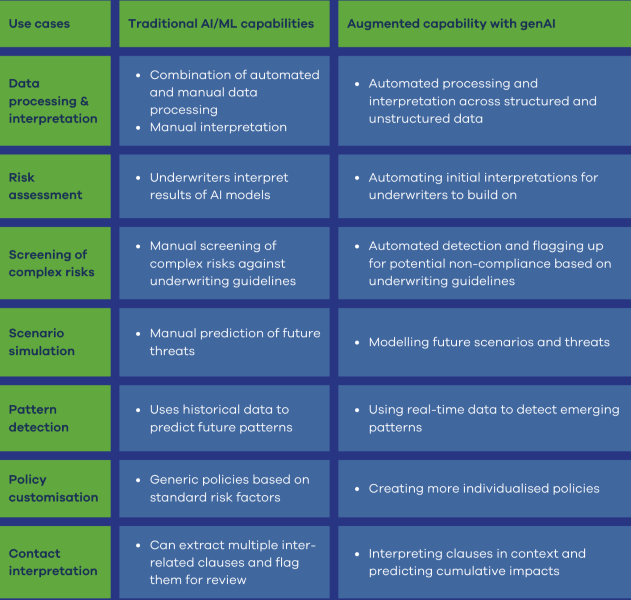GenAI in decision making: 3 use cases for insurers
The insurance industry is fundamentally powered by data. Generative AI, combined with advancements in machine learning, natural language processing and data analytics, has the potential to transform how the sector uses its data to support decision making.
So, how can insurers get started on their genAI journey?
- Step 1- Identify the business problems that could benefit most from genAI
- Step 2- Evaluate how genAI could compliment and extend existing capabilities
To help insurance organisations understand how genAI can help beyond the more obvious use cases (chatbots, summarisation and claims triaging), here are three use cases in more complex and less commoditised business areas:
Scenario 1- Underwriting cyber insurance
Business Problem
The Cyber risk insurance market is one of the fastest growing areas of Insurance. Underwriters spend a great deal of time compiling and analysing complex information from multiple sources including the client's IT infrastructure, historical cyber incidents, current industry landscape and regulatory requirements.
How can genAI help
- Accelerate vulnerability identification by proactively analysing data from sources such as emails, documents, logs etc., and sourcing data directly from the insured company's IT infrastructure.
- Compile initial risk assessments for underwriters to build upon based on training against the insurer’s historical claims dataset.
- Identify future threats based on emerging threat vectors, industry trends and open-source intelligence.
Benefits
- Underwriters can make informed decisions faster and more accurately, reducing the time and manual effort required to formulate the policy.
- GenAI can help underwriters interpret the results of traditional predictive models, saving manual effort and increasing efficiency.
Scenario 2 - Flood risk for property insurance
Business Problem
Climate change is causing more extreme and severe weather events, making it more challenging for insurers to accurately price and underwrite flood risk for property insurance in the UK. Insurers need to evaluate a multitude of factors such as historical flood data and climate models, sifting through extensive datasets to integrate various sources of information to assess and set appropriate premiums.
How can genAI help
Aside from ingesting and analysing data from disparate sources, genAI can help:
- Re-shape raw, unstructured data into formats suitable for ML models.
- Identify patterns and correlations within the data that may not be immediately apparent to human analysts.
- Interpret algorithmic results with natural language querying and explanations.
Benefits
- Underwriters can gain deeper insights into data and make more accurate decisions faster.
- The capabilities of traditional predictive models are enhanced.
Scenario 3 - Assessing aggregate risk exposures
Business Problem
Reinsurance firms must evaluate the aggregated risks they carry across various primary insurers. This involves assessing the risk exposures of multiple policies across different sectors and geographic locations, often dealing with massive datasets and complex risk models.
How can genAI help
GenAI can streamline this risk assessment process by:
- Automating screening and compliance checking by comparing incoming risk proposals against coverage guidelines and flagging potential non-compliant risks, or high-risk areas where further re-insurance may be desirable.
- Identifying correlations and potential risk accumulations that may not be apparent to underwriters.
- Simulating catastrophe scenarios, predicting potential loss events, and optimizing the reinsurance portfolio to minimize risk exposure.
Benefits
- Enhances productivity of employees while improving risk assessment accuracy, leading to better decision making and reduced financial exposure for reinsurance.
Summary of insurance use cases augmented by genAI

While genAI implementation can bring a variety of benefits to insurance organisations, it needs to be part of a wider internal transformation strategy encompassing data and analytics, machine learning, and a culture of continuous iteration, deployment and learning.
Discover the practical steps needed to get the most out of genAI with our exclusive guide and learn how to identify priority use cases, prepare your data and continually evaluate your results to maximise your business benefits from genAI.
